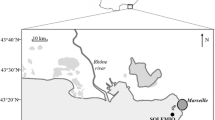Abstract
Substrate transformation and microbial biomass production in aquatic ecosystems depend mainly on the total number of actively metabolizing heterotrophic bacteria. The most common methods used concern the determination of either the colony-forming bacteria or the total number of bacteria including autotrophs and inactive organisms a micro-autoradiographic method is presented which enables the substrate uptake of single bacteria by means of 3H-amino-acid mixture and Nuclepore filters to be determined. The standardization procedure revealed the greatest success after 3 h incubation with 10 μCi/ml tritiated amino-acid mixture and an exposure of 14 days to the X-ray film. Preliminary experiments showed inactivation of an active fresh-water population from 100% to 0.6% within 3 h at 28‰S. With increasing distance from the shore, the number of colony-forming units decreases from 6 to 0.01% of the total number of active heterotrophic bacteria. It is concluded from the results that the fraction of very small heterotrophic bacteria which cannot be cultured on nutrient media is responsible for the continuous breakdown of organic matter in off-shore regions of the sea.
Similar content being viewed by others
Literature Cited
Allen, H.L.: Dissolved organic carbon utilization in size-fractionated algal and bacterial communities. Int. Revue ges. Hydrobiol. 56, 731–749 (1971)
Berlin, M. and R. Rylander: Autoradiographic detection of radioactive bacteria introduced into sea water and sewage. J. Hyg., Camb. 61, 307–315 (1963)
Brock, M.L. and T.D. Brock: The application of micro-autoradiographic techniques to ecological studies. Mitt. int. Verein. theor. angew. Limnol. 15, 1–29 (1968)
Brock, T.D.: Bacterial growth rate in the sea: direct analysis by thymidine autoradiography. Science, N.Y. 155, 81–83 (1967)
Gocke, K.: Untersuchungen über den Einfluß des Salzgehaltes auf die Aktivität von Bakterienpopulationen des Süß- und Abwassers. Kieler Meeresforsch. 30, 99–106 (1974)
Hellebust, J.A.: Excretion of some organic compounds by marine phytoplankton. Limnol. Oceanogr. 10, 192–206 (1965)
Hobbie, J.E. and C.C. Crawford: Respiration corrections for bacterial uptake of dissolved organic compounds in natural waters. Limnol. Oceanogr. 14, 528–532 (1969)
Hoppe, H.-G.: Untersuchungen zur Ökologie der Hefen im Bereich der westlichen Ostsee. Kieler Meeresforsch. 28, 54–77 (1972)
—: Untersuchungen zur Analyse mariner Bakterienpopulationen mit einer autoradiographischen Methode. Kieler Meeresforsch. 30, 107–116 (1974)
Horner, R. and V. Alexander: Algal populations in arctic sea ice: an investigation of heterotrophy. Limnol. Oceanogr. 17, 454–457 (1972)
Ishida, Y. and H. Kadota: A comparison between viable count and direct count of bacteria in polluted sea water. Bull. Jap. Soc. scient. Fish. 41, p. 271 (1975)
Hannasch, H.W.: Biological significance of bacterial counts in aquatic environments. Contr. Woods Hole oceanogr. Instn 1490, 127–131 (1965)
Liu, M.S. and J.A. Hellebust: Uptake of amino acids by the marine centric diatom Cyclotella cryptica. Can. J. Microbiol. 20, 1109–1118 (1974)
Munro, A.L.S. and T.D. Brock: Distinction between bacterial algal utilization of soluble substances in the sea. J. gen. Microbiol. 51, 35–42 (1968)
Oppenheimer, C.H. (Ed.): Marine biology, Vol. IV. 485 pp. New York: New York Academy of Sciences, 1968
Paerl, H.W.: Bacterial uptake of dissolved organic matter in relation to detrital aggregation in marine and freshwater systems. Limnol. Oceanogr. 19, 966–972 (1974)
— and C.R. Goldmann: Heterotrophic assays in the detection of water masses at Lake Tahoe, California. Limnol. Oceanogr. 17, 145–148 (1972)
Parsons, T.D. and J.D.H. Strickland: On the production of particulate organic carbon by heterotrophic processes in the sea water. Deep-Sea Res. 8, 211–222 (1962)
Peroni, C. and O. Lavarello: Microbial activities as a function of water depth in the Ligurian Sea: an autoradiographic study. Mar. Biol. 30, 37–50 (1975)
Ramsay, A.J.: The use of autoradiography to determine the proportion of bacteria metabolizing in an aquatic habitat. J. gen. Microbiol. 80, 363–373 (1974)
Rheinheimer, G.: Mikrobiologische Untersuchungen in der Elbe zwischen Schnackenburg und Cuxhaven. Arch. Hydrobiol. (Suppl. Elbe-Aestuar) 29, 181–251 (1965)
—: Einige Beobachtungen über den Einfluß von Ostseewasser auf limnische Bakterienpopulationen. Veröff. Inst. Meeresforsch. Bremerh. (Sonderbd) 2, 237–244 (1966)
—: Die Bedeutung des Elbe-Ästuars für die Abwasserbelastung der südlichen Nordsee in bakteriologischer Sicht. Helgoländer wiss. Meeresunters. 17, 445–454 (1968)
Rogers, A.W.: Techniques of autoradiography, 372 pp. Amsterdam, London, New York: Elsevier Scientific Publishing Co. 1973
Saunders, G.W.: Potential heterotrophy in a natural population of Oscillatoria agardhii var. isothrix Skuja. Limnol. Oceanogr. 17, 704–711 (1972)
Sheldon, R.W.: Size separation of marine seston by membrane and glass-fiber filters. Limnol. Oceanogr. 17, 494–498 (1972)
Sorokin, J.I.: The use of 14C in the study of nutrition of aquatic animals. Mitt. int. Verein. theor. angew. Limnol. 16, 1–41 (1968)
Watt, W.D.: Measuring the primary production rates of individual phytoplankton species in natural mixed populations. Deep-Sea Res. 18, 329–339 (1971)
Williams, P.J. LeB.: Heterotrophic utilization of dissolved organic compounds in the sea. I. Size distribution of population and relationship between respiration and incorporation of growth substrates. J. mar. biol. Ass. U.K. 50, 859–870 (1970)
Wright, R.T. and E.J. Hobbie: The use of glucose and acetate by bacteria and algae in aquatic ecosystems. Ecology 47, 447–464 (1966)
Zimmermann, R. and L.-A. Meyer-Reil: A new method for fluorescence staining of bacterial populations on membrane filters. Kieler Meeresforsch. 30, 24–27 (1974)
Zobell, C.E.: Marine microbiology. Chronica bot. 1–240 (1946)
Author information
Authors and Affiliations
Additional information
Communicated by O. Kinne, Hamburg
Rights and permissions
About this article
Cite this article
Hoppe, H.G. Determination and properties of actively metabolizing heterotrophic bacteria in the sea, investigated by means of micro-autoradiography. Marine Biology 36, 291–302 (1976). https://doi.org/10.1007/BF00389190
Accepted:
Issue Date:
DOI: https://doi.org/10.1007/BF00389190




